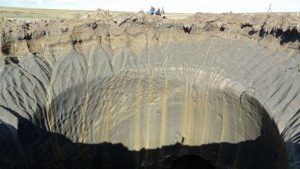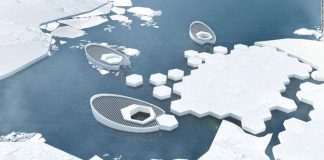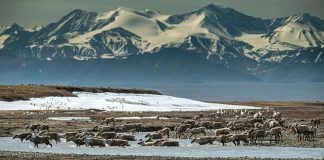FEBRUARY 11, 2021

A photo taken on August 25, 2014 shows a crater on the Yamal Peninsula, northern Siberia. Photo: Vasily Bogoyavlensky (Getty Images)
The Siberian tundra is still out here exploding. A new study from the Woodwell Climate Research Center has identified three new craters in the region’s increasingly volatile permafrost, and the climate crisis is to blame.
Researchers have been seeing giant holes form in western Siberia’s Yamal Peninsula for years. The first, discovered by workers back in 2014, measured 262 feet (80 meters) in diameter. Since then, scientists have found another six craters on Yamal and the nearby Gydan peninsula, most recently discovering a crater as deep as half a football field last year. While researchers have suspected explosive methane gas has welled up into the tundra as it thaws and caused the explosions, it’s been an area of active research.
“These craters represent an Earth system process that was previously unknown to scientists,” Sue Natali, Arctic program director at Woodwell Climate Research Center and co-author on the study, said in an emailed statement.
To learn more about how these holes form, the researchers used satellite data from Siberia’s Yamal and Gydan peninsulas—a combined area of 126,255 square miles (327,000 square kilometers)—to create an artificial intelligence-based model of the region with Google Earth Engine’s cloud computing platform. The model located all seven of the previously-discovered craters, and also indicated that three more of them have formed.
The researchers found that the craters begin forming deep underground, in pockets of thawed earth known as taliks. These taliks frequently form beneath Arctic lakes when the water within them warms. Methane can build in these pockets. As pressure grows, it can lead to explosive results.
In addition to uncovering the three new holes, the model showed previously unseen stark changes across the two peninsulas. It found that between 1984 and 2017, about 5% of the examined area has seen observable ecosystem changes, including “shifts in vegetation, elevation, and water extent.” Entire lakes have disappeared, draining out completely as the permafrost—frozen ground made of soil, rocks, and water—that forms their outer edges and bottoms melted away amid rising temperatures. Huge swaths of the region have also become greener because higher air and soil temperatures have increased plant growth. Due to permafrost thaw and ice melt, parts of the region are also sinking.
All of these changes spell trouble for Arctic ecosystems and the rest of the world. As lakes drain, fish and other wildlife are being left without a home and Indigenous communities have seen their water supplies dry up. Arctic greening is also an issue, since taller and heartier foliage can trap more snow beneath them. That in turn can lead to more rapid thawing of permafrost because the snow acts like a blanket that can actually keep the ground relatively warmer than the frigid air above it.
Permafrost thaw itself is dangerous. It’s left coasts more vulnerable to dangerous erosion, and it threatens to unleash the planet-warming methane currently stored safely beneath the ground into the atmosphere. The craters are the most dramatic example of that, but they’re hardly the only way methane and carbon dioxide escape from the tundra. Scientists have found that the Arctic is emitting more carbon from formerly frozen soils than it takes up, creating a dangerous situation for the climate.
As the planet continues to warm, the researchers expect these changes will occur more quickly. That includes the methane explosions, since they’re more likely to occur when the ground’s pressure rises or ice on the ground thaws and breaks suddenly. Many of these changes won’t be reversible, either. So for the sake of the Arctic and the rest of the planet, we better get global warming under control.
Courtesy/Source: GIZMODO










































































































